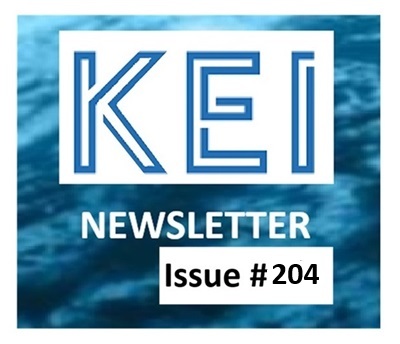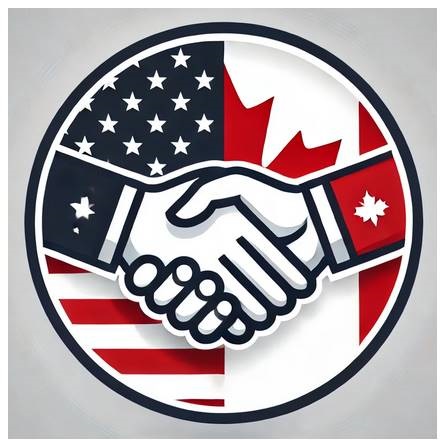|
Crime in Canada Exposed - Webinar Recording |
DIRECTORY | ||
|
Contributions: |
Action: Help sustain KEI's contributions |
Event: Sovereignty At Risk? Dinner & Discussion February 28th, Calgary Register $57 HERE |
|
|
Editor - Perry Kinkaide |
Politics today is increasingly divisive. Leaders when not making promises are often making excuses, manipulating the public, or both. Policies are frequently reactionary—driven by opposition, crises, or the need to appear decisive—without careful thought. These decisions come with costs, but accountability is rare, and while the original cause is often forgotten and the panic fades into history - the consequences live on: distrust, debt and indebtedness.
Consider COVID-19. The articles below and KEI's webinar on Thursday each examine the pandemic’s impact and consequences, the roles and often conflicting interests of doctors serving patients, officiers serving public healthcare, and politicians serving society at large, and the lessons to be learned. Note, it is rare that we have an opportunity to ask ourselves, how did we do? The first article reflects on how Covid-19 has been treated in the varioius KEI Network's newsletters and webinars. - Editor |
||
The KEI Network's Ongoing Commentary on COVID-19As the world navigated the uncharted waters of the COVID-19 pandemic, the discourse surrounding its management became a blend of science, politics, and public sentiment. The KEI Network through its newsletters and webinars continues to provide a critical platform for dialogue, delving into the complexities of pandemic management, the societal impacts, and the often controversial approaches to dealing with the virus and the pandemic. This newsletter aims to set the stage for KEI's webinar this Thursday where experts will dissect these issues further, sharing lessons learned to better prepare for future global health crises. - continued below.
No Registration Necessary - Just check in https://us02web.zoom.us/j/84258596166?pw..- continued from above. Early Reactions and Ongoing Challenges. The onset of the pandemic saw governments worldwide scrambling to implement measures to curb the spread of the virus. In Canada, this began in January 2020 with the first reported case leading to swift public health interventions. However, as KEI Network's highlighted a year later in January 2021, the staying power of COVID-19 was underestimated. The newsletter raised poignant questions about humanity’s role in perpetuating the pandemic, critiquing the reliance on vaccines and the ephemeral hope that summer and social distancing alone could halt the virus. It painted a picture of a society caught in a cycle of reactive measures rather than proactive resilience, a theme that resonated deeply as the pandemic evolved. Pending resolution as we reflect on what we might have done differently.
Navigating Misinformation and Trust. By January 2021, the conversation had shifted towards the overwhelming influx of information and misinformation. Issue #21 addressed the confusion permeating all levels of society, from the misinterpretation of public events like the storming of the US Capitol to the polarized views on pandemic management strategies. This newsletter underscored the critical challenge of discerning truth in an era where multiple realities coexist, amplified by media biases and the politicization of science. A challenge that continues on today.
Technological and Societal Transformations. The pandemic accelerated the digital transformation, forcing sectors like education and healthcare to adapt rapidly. However, as KEI Network pointed out, this shift also laid bare the inequalities within societies, particularly in access to technology and resources. The discussions extended to the impact on mental health, the resilience of institutions, and the broader implications for societal norms and structures, suggesting that the effects of the pandemic would be long-lasting and far-reaching. And so they are.
The Broader Context: Pandemics and Other Global Challenges. KEI Network’s newsletters did not shy away from drawing parallels between the management of COVID-19 and other global challenges, such as climate change. In a comparative analysis, the newsletters argued that just as pandemic responses have required significant societal shifts and trust in science, so too will efforts to mitigate climate change demand a rethinking of personal and collective behaviors. While "trust the science" resonates, who to trust to speak for science?
Preparing for the Future. As we approach Thursday's webinar, the insights from KEI Network’s newsletters offer a valuable framework for discussion. The lessons from COVID-19 are clear: management of such crises requires not only immediate and science-based responses but also a deeper understanding of the human and perhaps more important, the social factors that influence the spread of a virus, as well as the effectiveness of interventions. The upcoming webinar promises to explore these dimensions, featuring voices that were central to managing the pandemic, offering a reflective look at what was learned and how those lessons can shape responses to future global health emergencies. Alberta's Management of COVID-19: Lessons and ControversiesAs governments around the world reflect on the responses to the COVID-19 pandemic, a heated debate continues over the measures implemented during the crisis. These ranged from stringent lock-downs and mask mandates to more lenient policies, creating a broad spectrum of strategies that have drawn both praise and criticism.
Varied Global Responses. Throughout the pandemic, public health officials and epidemiologists largely supported strict measures, arguing that without aggressive actions, the virus would have resulted in far more catastrophic loss of life. This perspective aligns with actions taken during past pandemics, such as the Spanish Flu of 1918 or the Asian Flu of 1957-1958, where delayed responses led to severe consequences.
"Groupthink" - see the following article, may explain the uniformity in global pandemic responses to the perceived threat of Covid-19, particularly in the early days. With limited information about the virus, many governments opted for a cautious approach modeled on the actions of those countries first affected. This strategy, while prudent in some respects, led to a homogenization of responses that were not always suited to local conditions.
On the other hand, critics argue that the severe restrictions infringed on personal freedoms and were disproportionate to the threat. They contend that the economic downturns, mental health crises, and erosion of trust in public institutions were exacerbated by these measures, which they claim were based on an overestimation of the virus's severity.
Alberta's Pandemic Strategy: A Closer Look. In late 2022, Premier Danielle Smith. Premier of Alberta, called for the formation of a panel to examine the provincial government’s response to the COVID-19 pandemic. The Alberta COVID-19 Pandemic Data Review Task Force's report HERE offer a detailed critique of Alberta's pandemic management. The report indicated that decisions in Alberta were heavily influenced by the dire situations in Italy and New York early in the pandemic, which may not have directly correlated with Alberta’s needs or conditions. The Task Force report also pointed out that many of Alberta’s actions lacked consideration for the long-term consequences and were too closely aligned with international responses without sufficient adaptation to local realities.
Controversies Surrounding the Alberta Task Force Report. The task force's report has stirred significant controversy, particularly among Alberta’s medical community. Criticized by the Alberta Medical Association for potentially spreading misinformation, the report challenged the effectiveness of vaccines and controversial treatments like ivermectin and hydroxy-chloroquine. Such positions have deepened the divisions within the province on how to manage future public health crises effectively.
Lessons for the Future. The pandemic has underscored several crucial lessons for managing future health crises. These include the need for flexibility and adaptability in government responses, the importance of balancing health measures with their economic and psychological impacts, and the critical role of clear and transparent communication. Moreover, the crisis highlighted the necessity for stronger global coordination and enhanced investment in public health infrastructure.
Moving Forward. As we move beyond COVID-19, the insights gained from both the successes and failures of pandemic management will be invaluable. Governments are urged to consider these lessons to prepare more effectively for future public health emergencies, ensuring that responses are not only comprehensive and swift but also balanced and mindful of their broader implications. This comprehensive evaluation and ongoing debate are vital for not just understanding the varied impacts of the pandemic measures but also for planning more resilient global and nuanced local responses for managing future public health threats. The Anatomy of a Panic: From "War of the Worlds" to COVID-19In 1938, Orson Welles’ radio dramatization of The War of the Worlds sent waves of panic through American households. Listeners tuning in late mistook the fictional Martian invasion for real news, revealing the power of mass media to stir hysteria. Decades later, Barbara Tuchman’s book - The March of Folly, documented how nations have repeatedly plunged into disastrous decisions, propelled by fear, misinformation, and groupthink. And long before modern neuroscience could explain it, Irving Janis identified the mechanics of groupthink—how policymakers, driven by consensus and suppressing dissent, could make catastrophically misguided decisions.
Fast forward to early 2020, and a familiar pattern emerged. The outbreak of COVID-19 triggered a global reaction of escalating anxiety, with information and misinformation spreading faster than the virus itself. Governments, under pressure to “do something,” enacted sweeping measures that would have profound and lasting consequences. In hindsight, the pandemic response—while undoubtedly necessary in many respects—also bears the hallmarks of historical mass panics, amplified by the hyper-connected digital age.
The Speed and Scale of Modern Hysteria. Unlike the slow-moving crises of the past, COVID-19 unfolded in an era of instant global communication. Social media platforms, 24-hour news cycles, and government briefings created a flood of real-time updates, where speculation often masqueraded as fact. In a phenomenon reminiscent of War of the Worlds, early reports about the virus’s origins, transmission, and fatality rates were often misleading or incomplete. Yet, under the pressure of an information vacuum, assumptions hardened into policies before scientific consensus could form.
Consider the infamous models predicting millions of deaths, which—while valuable in shaping precautionary measures—led to worst-case-scenario lock downs that crippled economies and social structures. The media, eager to retain audiences, sensationalized the crisis, often focusing on worst-case projections rather than evolving realities. This cycle of escalating fear pressured governments into action, sometimes without fully considering long-term trade-offs.
The Political Imperative: Act First, Question Later. As in past crises, politicians found themselves trapped in a dynamic where fear dictated action. Early on, leaders were criticized for doing too little, too late. As the virus spread, the critique reversed: leaders were accused of overreach. The lockdowns, school closures, travel bans, and mask mandates were largely driven by an effort to appear decisive. No politician wanted to be blamed for inaction.
In Tuchman’s The March of Folly, she describes how leaders throughout history have pursued policies even when mounting evidence suggested their futility. The Vietnam War, the U.S. invasion of Iraq, and the Catholic Church’s refusal to address corruption in the 16th century all followed this script. COVID-19 was no different. Governments, once committed to strict lock downs, found it difficult to change course—even as evidence emerged that the virus disproportionately affected the elderly and those with pre-existing conditions.
The Consequences of Fear-Driven Policy. A key feature of mass hysteria is the inability to calculate trade-offs rationally. The early COVID-19 response focused exclusively on reducing immediate deaths from the virus, while downplaying collateral damage:
From War of the Worlds to COVID-19: Lessons in Collective Panic. Mass panics follow a familiar trajectory: an initial crisis, an explosion of information (both accurate and false), a rush to action by authorities, and unintended consequences. The COVID-19 pandemic mirrored this pattern but at an unprecedented scale. The digital era has made it easier than ever for fear to spread unchecked, for politicians to feel compelled to act before evidence solidifies, and for societies to find themselves locked into courses of action they struggle to reverse.
In the end, while COVID-19 was undoubtedly a real and serious crisis, its handling was shaped not just by science but by a deeply human and social tendency: the impulse for both to react in fear, rather than respond with measured reason. As the world faces future crises—whether pandemics, climate disasters, or geopolitical conflicts—it must recognize the dangers of succumbing to the same cycles of hysteria. Otherwise, as history has shown, we will remain locked in the same march of folly. The Final Word - Are We Ready for Next Time?What is clear and indisputable, is that everybody wanted to help. Covid was on the loose. Doctors wanted the best for patients of all ages. Health officers wanted the best for the public. Politicians - confronted by conflicting information and the clash of patient and public interests, listened to both, and in retrospect ignored the overall societal cost.
Policy decisions were complicated. Uncertainty prevailed: it is/not serious, do/don't vaccinate, do/don't mask, do/don't mandate. There was no Emergency Plan; but there was and it too was ignored.
Individuals even well-credentialed petitioners had solid evidence of what to do, who to target, when and why, but were viewed as contrarian or lone-wolf crack-pots. First frustrated, then angry, they were dismissed for bad manners. Best was to either do nothing or err at least on the side of caution.
And so the globe - with a few exceptions, took the high road and locked down virtually everything, everywhere, and everyone - seniors to children included. The pain, the losses, the costs, were astronomical and linger on as a post-Covid hangover.
The story will be told that mandates and all were excessive, the product of fear and a global group think. "We just had to do something"; and indeed they did. The question remains: What did we learn? Will we do better next time?
Editor@KEInetwork.net |



